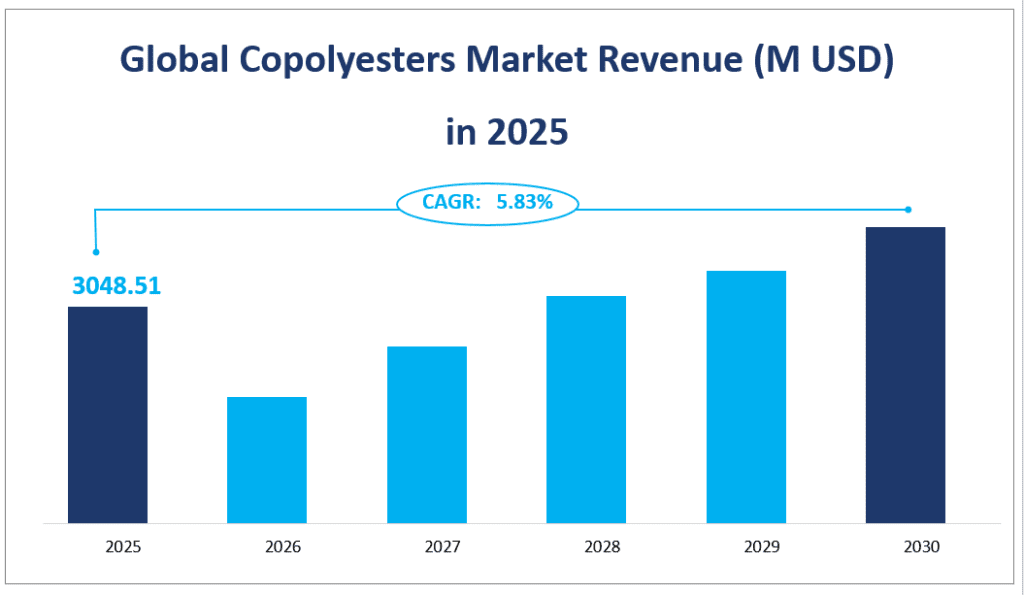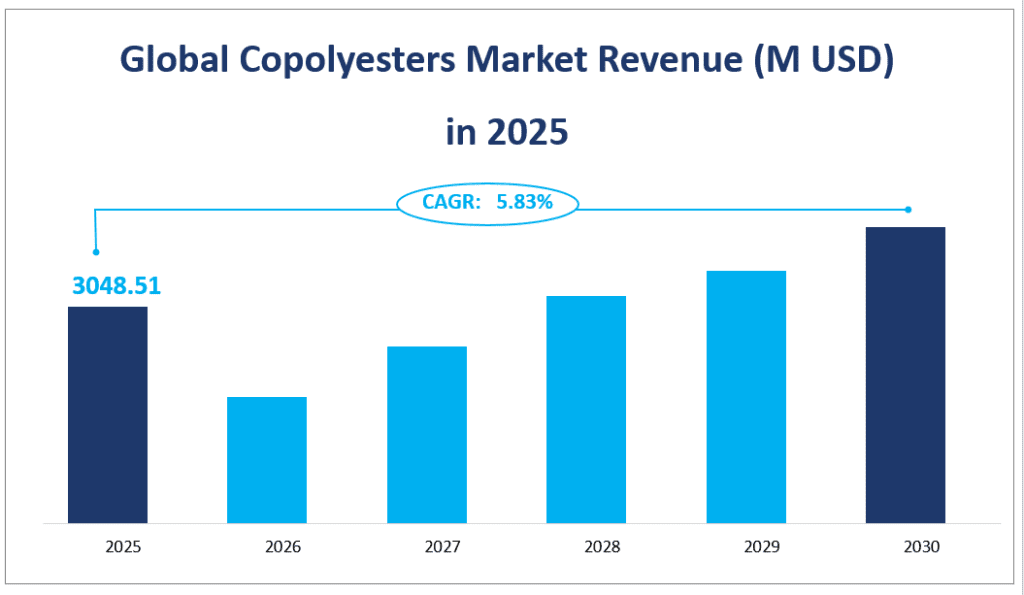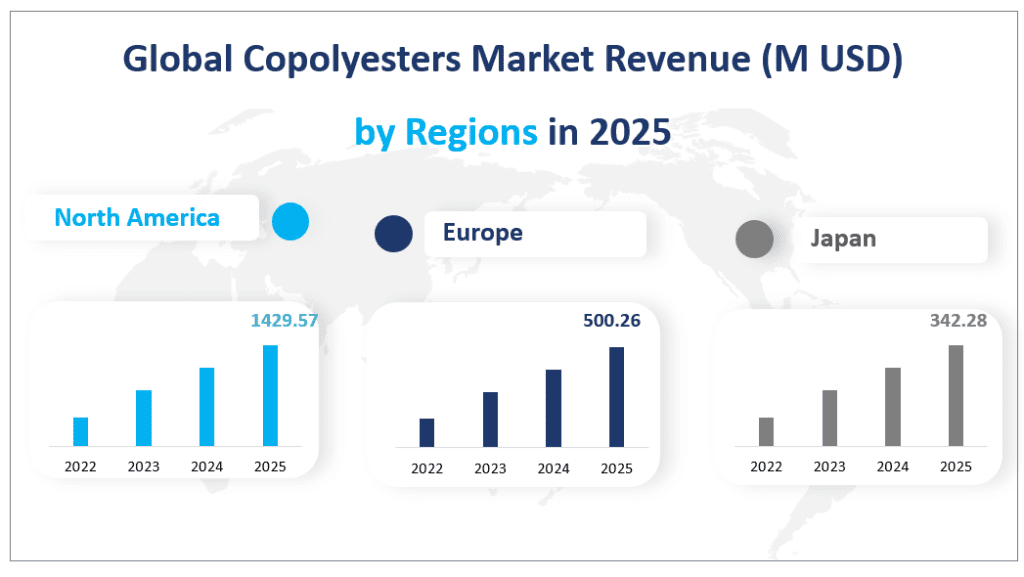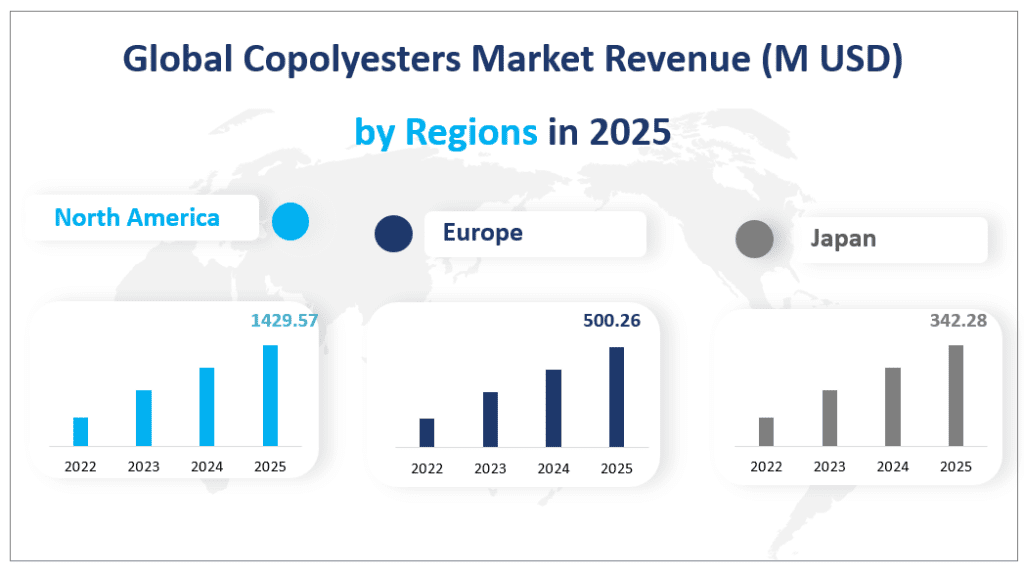1. Global Copolyesters Market Overview
By 2025, the global copolyesters market is projected to achieve a revenue of $3,048.51 million with a CAGR of 5.83% from 2025 to 2030, indicating a robust expansion in the industry.
Copolyesters, which are modified versions of polyesters, offer enhanced properties such as improved mechanical strength, chemical resistance, and transparency. These characteristics make them highly versatile and suitable for a wide range of applications, including packaging materials, electronics, automotive components, and medical devices. The market’s growth is further supported by increasing demand from these sectors, as well as advancements in manufacturing technologies that allow for more efficient production and customization of copolyesters.
Global Copolyesters Market Revenue (M USD) in 2025


2. Driving Factors of the Copolyesters Market
The growth of the global copolyesters market is influenced by several key factors. Firstly, the increasing demand for high-performance materials in various industries is a significant driver. As industries such as automotive, electronics, and healthcare evolve, they require materials that can withstand harsh conditions, offer durability, and maintain functionality. Copolyesters meet these requirements through their enhanced mechanical and chemical properties. For example, in the automotive industry, the shift towards lightweight materials to improve fuel efficiency and reduce emissions has led to a higher demand for copolyesters market, which can replace heavier materials without compromising on performance.
Secondly, the growing focus on sustainability and environmental impact is another driving factor. Many copolyesters are recyclable and can be produced using more sustainable processes compared to traditional plastics. This aligns with the global trend towards reducing plastic waste and promoting circular economy practices. Companies are increasingly investing in research and development to create more eco-friendly copolyesters, further expanding their market potential.
Thirdly, technological advancements in polymer science and manufacturing processes have enabled the production of copolyesters market with tailored properties to meet specific industry needs. Innovations in catalysts and polymerization techniques have improved the efficiency and cost-effectiveness of copolyester production, making them more accessible to a broader range of applications. This has led to increased adoption across industries, driving market growth.
3. Limiting Factors of Copolyesters Market
Despite the numerous advantages and growth opportunities, the copolyesters market also faces certain challenges. One of the primary limiting factors is the fluctuation in raw material prices. The cost of key raw materials such as terephthalic acid (TPA) and ethylene glycol (EG) can vary significantly due to market conditions and supply chain disruptions. This volatility can impact the profitability of copolyester manufacturers and deter potential investors.
Another challenge is the competition from alternative materials. In some applications, copolyesters may face competition from other high-performance polymers or composite materials that offer similar or superior properties at a lower cost. This competition can limit the share that copolyesters market can capture in certain segments.
Lastly, the global economic environment and regulatory policies also play a role in limiting market growth. Economic downturns can reduce demand from key industries such as automotive and construction, while stringent regulatory requirements related to material safety and environmental impact can increase the cost of compliance for copolyester manufacturers.
In conclusion, the global copolyesters market is set for substantial growth driven by increasing industry demand, sustainability trends, and technological advancements. However, challenges such as raw material price volatility, competition from alternative materials, and economic and regulatory factors need to be addressed to ensure sustained market expansion.
4. Analysis of the Global Copolyesters Market Segment
Product Types
PETG is anticipated to dominate the market in terms of revenue. By 2025, PETG is expected to generate a revenue of $1,816.22 million, accounting for approximately 59.58% of the total market revenue. PETG’s high transparency, excellent mechanical strength, and chemical resistance make it a preferred choice for applications such as packaging materials, medical devices, and consumer electronics. Its versatility allows it to be processed using various techniques, including injection molding, extrusion, and blow molding, further expanding its market reach.
PCTG and PCTA are also significant players in the copolyesters market. By 2025, PCTG and PCTA are projected to achieve a combined revenue of $260.04 million, representing about 8.53% of the total market revenue. PCTG is known for its high heat resistance and chemical stability, making it suitable for high-temperature applications and food packaging. PCTA, on the other hand, offers excellent mechanical properties and is used in specialized packaging applications. The growth of these types is driven by increasing demand from industries such as automotive, electronics, and healthcare, where high-performance materials are required.
The “Others” category, which includes various specialized copolyesters market, is expected to generate a revenue of $972.25 million by 2025, accounting for 31.89% of the total market revenue. This category encompasses copolyesters with unique formulations tailored for specific applications, such as high-temperature resistant materials for automotive components or biocompatible materials for medical devices. The growth of this segment is driven by the increasing need for customized solutions in various industries.
Market by Applications
Packaging Materials are expected to have the largest market share in terms of consumption. By 2025, this application is projected to consume 426.4 thousand tons of copolyesters, accounting for approximately 41.62% of the total market consumption. The growth of this segment is driven by the increasing demand for high-performance packaging solutions that offer durability, transparency, and chemical resistance. Copolyesters such as PETG are widely used in food and beverage packaging, pharmaceutical packaging, and consumer goods packaging due to their excellent properties.
Electronics & Appliances is another significant application area. By 2025, this segment is expected to consume 281.9 thousand tons of copolyesters, representing about 27.51% of the total market consumption. The growth of this application is driven by the increasing demand for lightweight, durable, and chemically resistant materials in the electronics industry. Copolyesters are used in the manufacturing of components such as casings, connectors, and insulators due to their excellent electrical insulation properties and mechanical strength.
Medical Devices are also a crucial application area for copolyesters. By 2025, this segment is projected to consume 88.2 thousand tons of copolyesters, accounting for 8.61% of the total market consumption. The growth of this application is driven by the increasing demand for biocompatible and sterilizable materials in the medical industry. Copolyesters such as PETG and PCTG are used in the production of medical devices, diagnostic equipment, and packaging materials due to their excellent properties.
The Automotive industry is another significant consumer of copolyesters. By 2025, this application is expected to consume 188.0 thousand tons of copolyesters, representing about 18.35% of the total market consumption. The growth of this segment is driven by the increasing demand for lightweight, high-performance materials in automotive components. Copolyesters are used in the manufacturing of interior components, under-the-hood parts, and exterior trim due to their excellent mechanical strength and chemical resistance.
The global copolyesters market is characterized by diverse product types and applications, each contributing differently to the overall market revenue and consumption. PETG is projected to dominate the market in terms of revenue, while packaging materials are expected to have the largest market share in terms of consumption. The growth of the market is driven by increasing demand from various industries, technological advancements, and sustainability trends. However, challenges such as raw material price volatility and competition from alternative materials need to be addressed to ensure sustained market expansion.
Market Value and Consumption by Segment
| Market Value (M USD) in 2025 | Market Share in 2025 | ||
| By Type | PETG | 1816.22 | 59.58% |
| PCTG, PCTA | 260.04 | 8.53% | |
| Others | 972.25 | 31.89% | |
| Consumption (K Tons) in 2025 | Market Share in 2025 | ||
| By Application | Package Materials | 426.4 | 41.62% |
| Electronics & Appliances | 281.9 | 27.51% | |
| Medical Devices | 88.2 | 8.61% | |
| Automotive | 188.0 | 18.35% | |
| Others | 40.1 | 3.91% |
5. Regional Copolyesters Market
North America is projected to remain the largest regional market by revenue in 2025, with an estimated revenue of $1,429.57 million. This region’s dominance is attributed to its strong industrial base, particularly in the automotive, electronics, and packaging sectors. The growth in this region is driven by increasing demand for high-performance materials in industries such as automotive and electronics, as well as a focus on sustainable and eco-friendly materials.
Europe is another significant contributor to the global copolyesters market, with an estimated revenue of $500.26 million in 2025. The region’s growth is driven by stringent regulations on material safety and environmental impact, which have led to increased adoption of copolyesters in packaging and automotive applications. Additionally, Europe’s strong chemical industry and focus on innovation contribute to its market position.
China is emerging as a key player in the global copolyesters market, with an estimated revenue of $199.24 million in 2025. The growth in China is driven by rapid industrialization, increasing demand from downstream industries such as packaging and electronics, and the government’s push for sustainable development. China’s market is also benefiting from technological advancements and increased investment in research and development.
Other regions such as Latin America, the Middle East, and Africa are also contributing to the global copolyesters market, with an estimated combined revenue of $577.17 million in 2025. The growth in these regions is driven by increasing industrialization, urbanization, and demand for high-performance materials in various sectors.
In terms of growth rates, China is expected to be the fastest-growing region. This rapid growth is attributed to China’s rapid industrial development, increasing demand from downstream industries, and the government’s focus on sustainable materials. North America and Japan are also expected to grow at significant rates of 5.96% and 5.99% respectively, driven by their strong industrial bases and focus on innovation.
Global Copolyesters Market Revenue (M USD) by Regions in 2025


6. Top 3 Companies in the Global Copolyesters Market
Company Introduction and Business Overview:
Eastman is a leading international chemical company with a history dating back to 1920. The company operates globally, producing a wide range of chemicals, fibers, and plastics. Eastman’s business segments include coatings, adhesives, specialty polymers, inks, fibers, performance chemicals, and specialty plastics. The company is known for its innovative and sustainable products, which cater to various industries.
Products Offered:
Eastman offers a variety of copolyesters under the brand name Eastar™. These include Eastar™ Copolyester 5011, which is a glycol-modified polyethylene terephthalate (PETG) known for its clarity, toughness, and ease of processing. Eastar™ 6763 is another product, which is a clear, amorphous material suitable for medical packaging due to its excellent performance properties such as clarity, toughness, and good melt strength.
Company Introduction and Business Overview:
SK Chemicals, established in 1969, is a leading manufacturer of high-performance materials. The company focuses on producing environmentally friendly materials and serves customers worldwide. SK Chemicals’ product portfolio includes composites, high-performance materials, and energy-saving materials, with a strong emphasis on innovation and sustainability.
Products Offered:
SK Chemicals offers a range of copolyesters, including SKYGREEN and ECOZEN. SKYGREEN is a high-performance copolyester with excellent transparency, chemical resistance, and processability, making it suitable for cosmetic containers and household goods. ECOZEN is a biomass-based transparent copolyester with high heat resistance, making it ideal for food containers and home appliances.
Company Introduction and Business Overview:
DuPont, established in 1802, is a global leader in specialty products. The company was formed through the merger of Dow Chemical and E. I. du Pont de Nemours and Company in 2017. DuPont’s business segments include Nutrition & Health, Industrial Biosciences, Safety & Protection, and Electronics & Communications. The company is known for its innovative and high-performance materials, which cater to various industries.
Products Offered:
DuPont offers Hytrel® Thermoplastic Elastomer, a versatile and durable copolyester. Hytrel® combines the flexibility of rubber with the strength and processability of thermoplastics, making it suitable for applications in the automotive, electronics, and industrial sectors. The product is known for its resilience, heat, and chemical resistance, and overall durability.
Major Players
| Company Name | Plant Locations | Market Distribution |
| Eastman | Mainly in USA, Asia | Worldwide |
| SK Chemicals | Mainly in Asia | Worldwide |
| DuPont | Mainly in America | Worldwide |
| BASF | Mainly in USA, Europe | Worldwide |
| Royal DSM | Mainly in Europe | Worldwide |
| Toyobo | Mainly in Japan | Worldwide |
| Celanese | Mainly in North America | Worldwide |
| Macroocean | Mainly in China | Mainly in Asia, America, Europe |
| Evonik | Mainly in Europe | Worldwide |
| Bostik | Mainly in Europe, North America | Worldwide |
1 Copolyesters Market Overview
1.1 Product Overview and Scope of Copolyesters
1.2 Copolyesters Segment by Type
1.2.1 Global Copolyesters Market Size Growth Rate Analysis by Type 2020 VS 2027
1.2.2 PETG
1.2.3 PCTG, PCTA
1.3 Copolyesters Segment by Applications
1.3.1 Copolyesters Consumption Comparison by Application: 2016 VS 2021 VS 2027
1.3.2 Package Materials
1.3.3 Electronics & Appliances
1.3.4 Medical Devices
1.3.5 Automotive
1.4 Global Copolyesters Market by Region
1.4.1 Global Copolyesters Market Size Estimates and Forecasts by Region: 2016 VS 2021 VS 2027
1.4.2 North America Copolyesters Estimates and Forecasts (2016-2027)
1.4.3 Europe Copolyesters Estimates and Forecasts (2016-2027)
1.4.4 China Copolyesters Estimates and Forecasts (2016-2027)
1.4.5 Japan Copolyesters Estimates and Forecasts (2016-2027)
1.5 Global Market Growth Prospects
1.5.1 Global Copolyesters Revenue Estimates and Forecasts (2016-2027)
1.5.2 Global Copolyesters Production Capacity Estimates and Forecasts (2016-2027)
1.5.3 Global Copolyesters Production Estimates and Forecasts (2016-2027)
2 Market Competition by Manufacturers
2.1 Global Copolyesters Production Capacity Market Share by Manufacturer
2.2 Global Copolyesters Revenue Market Share by Manufacturer (2016-2021)
2.3 Copolyesters Market Share by Company Type (Tier 1, Tier 2 and Tier 3)
2.4 Global Copolyesters Average Price by Manufacturers (2016-2021)
2.5 Manufacturers Copolyesters Production Sites, Area Served
2.6 Copolyesters Market Competitive Situation and Trends
2.6.1 Copolyesters Market Concentration Rate
2.6.2 Global Top 5 and Top 10 Players Market Share by Revenue
2.6.3 Mergers & Acquisitions, Expansion
3 Production and Capacity by Region
3.1 Global Production Capacity of Copolyesters by Regions (2016-2021)
3.2 Global Copolyesters Revenue and Market Share by Regions
3.3 Global Copolyesters Production, Revenue, Price and Gross Margin (2016-2021)
3.4 North America Copolyesters Production
3.4.1 North America Copolyesters Production Growth Rate (2016-2021)
3.4.2 North America Copolyesters Production Capacity, Revenue, Price and Gross Margin (2016-2021)
3.5 Europe Copolyesters Production
3.5.1 Europe Copolyesters Production Growth Rate (2016-2021)
3.5.2 Europe Copolyesters Production, Revenue, Price and Gross Margin (2016-2021)
3.6 China Copolyesters Production
3.6.1 China Copolyesters Production Growth Rate (2016-2021)
3.6.2 China Copolyesters Production, Revenue, Price and Gross Margin (2016-2021)
3.7 Japan Copolyesters Production
3.7.1 Japan Copolyesters Production Growth Rate (2016-2021)
3.7.2 Japan Copolyesters Production, Revenue, Price and Gross Margin (2016-2021)
4 Global Copolyesters Consumption by Region
4.1 Global Copolyesters Consumption by Regions
4.1.1 Global Copolyesters Consumption by Region
4.1.2 Global Copolyesters Consumption Market Share by Region
4.2 North America
4.2.1 North America Copolyesters Consumption by Country
4.2.2 U.S.
4.2.3 Canada
4.3 Europe
4.3.1 Europe Copolyesters Consumption by Country
4.3.2 Germany
4.3.3 France
4.3.4 U.K.
4.3.5 Italy
4.3.6 Russia
4.4 Asia Pacific
4.4.1 Asia Pacific Copolyesters Consumption by Region
4.4.2 China
4.4.3 Japan
4.4.4 South Korea
4.4.5 Taiwan
4.4.6 Southeast Asia
4.4.7 India
4.4.8 Australia
4.5 Latin America
4.5.1 Latin America Copolyesters Consumption by Country
4.5.2 Mexico
4.5.3 Brazil
5 Production, Revenue, Price Trend by Type
5.1 Global Copolyesters Production and Market Share by Type (2016-2021)
5.2 Global Copolyesters Revenue Market Share by Type (2016-2021)
5.3 Global Copolyesters Price by Type (2016-2021)
6 Global Copolyesters Market Analysis by Application
6.1 Global Copolyesters Consumption Market Share by Applications (2016-2021)
6.2 Global Copolyesters Consumption Growth Rate by Application (2016-2021)
7 Key Companies Profiled
7.1 Eastman
7.1.1 Eastman Copolyesters Corporation Information
7.1.2 Copolyesters Product Introduction
7.1.3 Eastman Copolyesters Production, Revenue, Price and Gross Margin (2016-2021)
7.2 SK Chemicals
7.2.1 SK Chemicals Copolyesters Corporation Information
7.2.2 Copolyesters Product Introduction
7.2.3 SK Chemicals Copolyesters Production, Revenue, Price and Gross Margin (2016-2021)
7.3 DuPont
7.3.1 DuPont Copolyesters Corporation Information
7.3.2 Copolyesters Product Introduction
7.3.3 DuPont Copolyesters Production, Revenue, Price and Gross Margin (2016-2021)
7.4 BASF
7.4.1 BASF Copolyesters Corporation Information
7.4.2 Copolyesters Product Introduction
7.4.3 BASF Copolyesters Production, Revenue, Price and Gross Margin (2016-2021)
7.5 Royal DSM
7.5.1 Royal DSM Copolyesters Corporation Information
7.5.2 Copolyesters Product Introduction
7.5.3 Royal DSM Copolyesters Production, Revenue, Price and Gross Margin (2016-2021)
7.6 Toyobo
7.6.1 Toyobo Copolyesters Corporation Information
7.6.2 Copolyesters Product Introduction
7.6.3 Toyobo Copolyesters Production, Revenue, Price and Gross Margin (2016-2021)
7.7 Celanese
7.7.1 Celanese Copolyesters Corporation Information
7.7.2 Copolyesters Product Introduction
7.7.3 Celanese Copolyesters Production, Revenue, Price and Gross Margin (2016-2021)
7.8 Macroocean
7.8.1 Macroocean Copolyesters Corporation Information
7.8.2 Copolyesters Product Introduction
7.8.3 Macroocean Copolyesters Production, Revenue, Price and Gross Margin (2016-2021)
7.9 Evonik
7.9.1 Evonik Copolyesters Corporation Information
7.9.2 Copolyesters Product Introduction
7.9.3 Evonik Copolyesters Production, Revenue, Price and Gross Margin (2016-2021)
7.10 Bostik
7.10.1 Bostik Copolyesters Corporation Information
7.10.2 Copolyesters Product Introduction
7.10.3 Bostik Copolyesters Production, Revenue, Price and Gross Margin (2016-2021)
8 Copolyesters Manufacturing Cost Analysis
8.1 Copolyesters Key Raw Materials Analysis
8.1.1 Key Raw Materials
8.1.2 Key Raw Materials Price Trend
8.1.3 Key Suppliers of Raw Materials
8.2 Proportion of Manufacturing Cost Structure
8.2.1 Raw Materials
8.2.2 Labor Cost
8.2.3 Manufacturing Expenses
8.3 Manufacturing Process Analysis of Copolyesters
8.4 Copolyesters Industrial Chain Analysis
9 Marketing Channel, Distributors and Customers
9.1 Marketing Channel
9.2 Copolyesters Distributors List
9.3 Copolyesters Customers
10 Market Dynamics
10.1 Copolyesters Industry Trends
10.2 Copolyesters Growth Drivers
10.3 Copolyesters Market Challenges
10.4 Porter’s Five Forces Analysis
11 Production and Supply Forecast
11.1 Global Forecasted Production of Copolyesters by Region (2022-2027)
11.2 Global Forecasted Revenue of Copolyesters by Region (2022-2027)
11.3 Global Forecasted Price of Copolyesters by Region (2022-2027)
11.4 Global Copolyesters Production Forecast by Regions
11.4.1 North America Copolyesters Production, Revenue Forecast (2022-2027)
11.4.2 Europe Copolyesters Production, Revenue Forecast (2022-2027)
11.4.3 China Copolyesters Production, Revenue Forecast (2022-2027)
11.4.4 Japan Copolyesters Production, Revenue Forecast (2022-2027)
12 Consumption and Demand Forecast
12.1 Global Forecasted Demand of Copolyesters
12.2 North America Consumption of Copolyesters by Country
12.3 Europe Consumption of Copolyesters by Country
12.4 Asia Pacific Copolyesters Consumption of Copolyesters by Country
12.5 Latin America Copolyesters Consumption of Copolyesters by Country
13 Forecast by Type and by Application (2022-2027)
13.1 Global Production, Revenue and Price Forecast by Type (2022-2027)
13.1.1 Global Forecasted Production of Copolyesters by Type (2022-2027)
13.1.2 Global Forecasted Revenue of Copolyesters by Type (2022-2027)
13.1.3 Global Forecasted Price of Copolyesters by Type (2022-2027)
13.2 Global Forecasted Consumption of Copolyesters by Application (2022-2027)
14 Research Findings and Conclusion
15 Appendix
15.1 Methodology
15.2 Research Data Source
15.2.1 Secondary Data
15.2.2 Primary Data
15.2.3 Market Size Estimation
15.2.4 Legal Disclaimer
